Caladenia moschata
(D.L.Jones) G.N.Backh.Flowering plant slender, 15–30 cm tall, green (sometimes tinged red). Leaf linear, 9–18 cm long, 3–5 mm wide. Flowers 1–5, white inside, often with pink or bronze colouring towards segment tips, strongly musk-scented; ovary 5–8 mm long; perianth segments 12–16 mm long, 4–6 mm wide, acute, outer surface with purplish-brown or greenish-brown, sessile and stalked glands; dorsal sepal hooded, curved at about middle, embracing column, narrowly elliptic; petals and lateral sepals spreading, tips often drooping, narrowly elliptic, slightly asymmetric, lateral sepals slightly broader than petals. Labellum on short claw, obscurely 3-lobed, 7.5–9 mm long, 6–7 mm wide (when flattened), white, spotted with red or purple; lateral lobes with entire margins; mid-lobe tightly recurved, tapered, pale purple or pink, margins fringed with numerous spreading calli with smooth stalks and granular heads (i.e. with minute rounded papillae), apex acute, purplish; lamina calli in four rows, extending from base almost to labellum apex, becoming sessile and irregularly arranged towards apex, clubbed, heads granular (those near base of labellum sometimes slightly toothed), purple or yellow. Column erect at base, upper third abruptly bent forward, widely winged above, often spotted with red; anther with short point Flowers Oct.–Dec.
LoM, Wim, GleP, VVP, VRiv, GipP, OtP, WaP, Gold, CVU, GGr, DunT, NIS, EGL, EGU, WPro, HSF, HNF, OtR, Strz, MonT, HFE, VAlp. Also ACT. Widespread throughout much of Victoria, often on hillsides in drier, open-forests (e.g. stringybark-peppermint communities).
Caladenia moschata differs from C. cucullata in having generally larger, non-compressed (vertically), strongly fragrant flowers in a longer, less compact raceme. Caladenia moschata is more widespread than C. cucullata, and is found in most areas (except mallee) where the latter species grows. See also notes under C. cucullata.
Entwisle, T.J. (1994). Orchidaceae. In: Walsh, N.G.; Entwisle, T.J., Flora of Victoria Vol. 2, Ferns and Allied Plants, Conifers and Monocotyledons, pp. 740–901. Inkata Press, Melbourne.
 Spinning
Spinning

